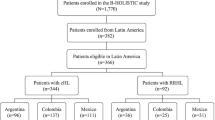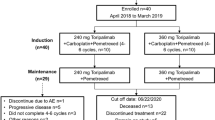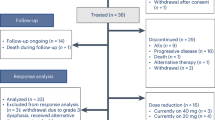Abstract
Biweekly THP-COPBLM including pirarubicin (THP), which is thought to be less toxic than doxorubicin, was used to treat non-Hodgkin's lymphoma (NHL) and the remission rate and adverse events were studied in 42 patients younger than 69 years. Complete remission (CR) was achieved in 37 patients (88.1%) and partial remission in five (11.9%). Classified by international prognostic index, CR was achieved in 16 out of 17 low–intermediate-risk patients, 14 out of 16 high–intermediate-risk patients and seven out of nine high-risk patients. The 3-year survival rate was 72.1% and the 3-year event-free survival rate was 58%. Grade 3 or higher adverse events included granulocytopenia in 39 patients (92.9%) and thrombocytopenia in seven (16.7%). The biweekly THP-COPBLM regimen appears useful for the treatment of aggressive intermediate- and high-grade NHL, and G-CSF made it possible to shorten the interval between courses of chemotherapy. Further studies regarding adverse events on organs, other than on bone marrow are required to improve the long-term results of combination therapy on NHL.
This is a preview of subscription content, access via your institution
Access options
Subscribe to this journal
Receive 12 print issues and online access
$259.00 per year
only $21.58 per issue
Buy this article
- Purchase on SpringerLink
- Instant access to full article PDF
Prices may be subject to local taxes which are calculated during checkout
Similar content being viewed by others
Author information
Authors and Affiliations
Rights and permissions
About this article
Cite this article
Niitsu, N., Umeda, M. Biweekly THP-COPBLM (pirarubicin, cyclophosphamide, vincristine, prednisone, bleomycin and procarbazine) regimen combined with granulocyte colony-stimulating factor (G-CSF) for intermediate- and high-grade non-Hodgkin's lymphoma. Leukemia 12, 1457–1460 (1998). https://doi.org/10.1038/sj.leu.2401134
Received:
Accepted:
Published:
Issue date:
DOI: https://doi.org/10.1038/sj.leu.2401134



